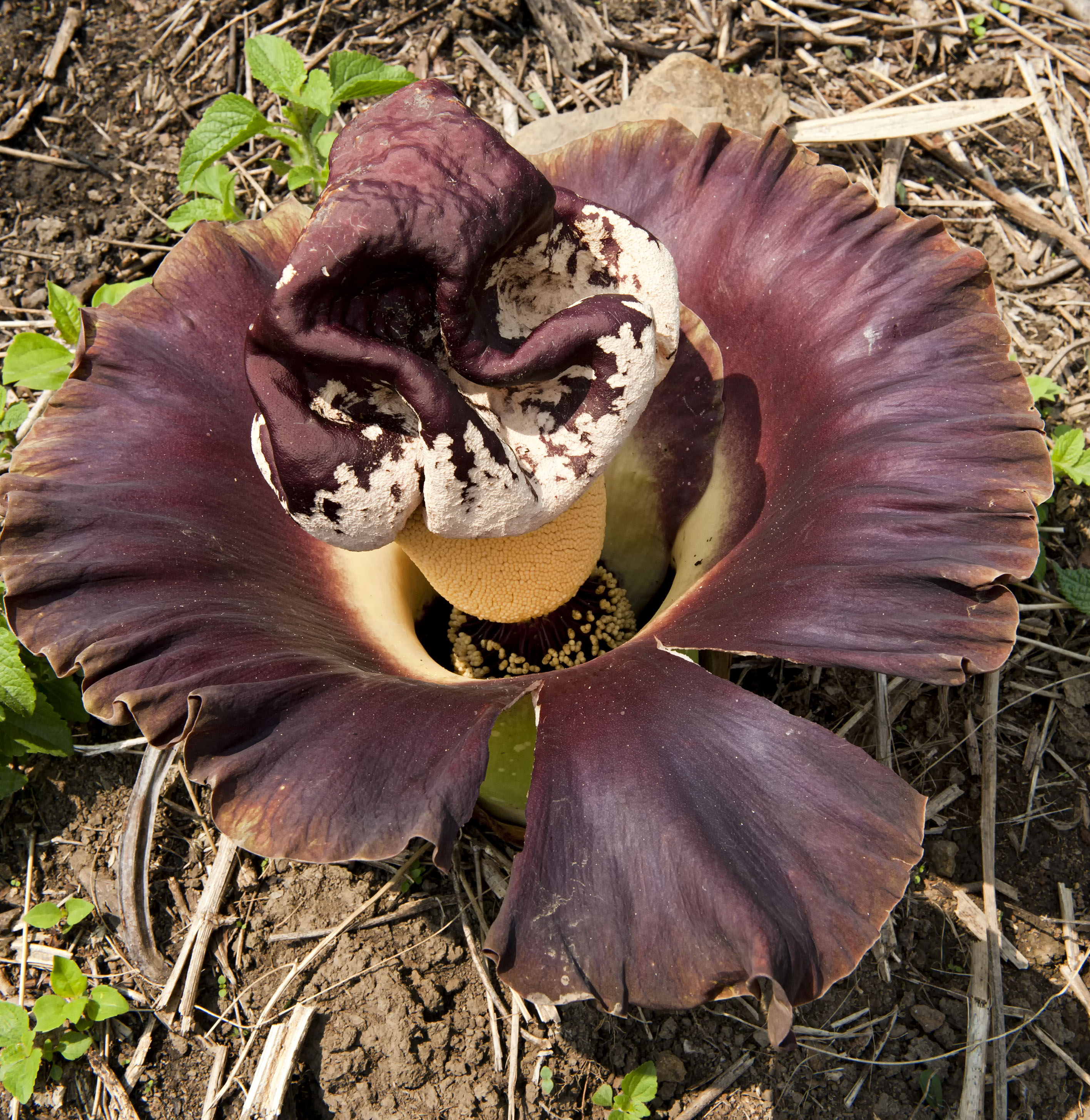ເລກລຳດັບທີ: 56
ລະດັບການຮວບຮວມຂໍ້ມູນ: ຂໍ້ມູນພື້ນຖານ
ປັບປູງຄັ້ງລ່າສຸດ: 2025-08-17
ຫົວກະບຸກ
Elephant Foot Yam
Amorphophallus paeoniifolius (Dennst.) Nicolson
ພືດ
ພືດລົ້ມລຸກ
ຜັກ ແລະ ພືດລົ້ມລຸກ
×
ຊື່ທ້ອງຖີ່ນ:
ລາວ: ຫົວດຸກເດືອ, ອິລອກໃຫຍ່.
ໄທ: ບຸກ, ບຸກຄ້າງໂຄກ, ມັນ ຊຸຣັນ, ເບຍ, ບົວບຸກ, ບຸກ ຄຸງໂຄກ, ບຸກນ້ຳ, ບຸກຫຼວງ, ກຣະບຸກ, ບັກກະເດືອ.
ກໍາປູເຈຍ: ຕວນ.
ຫວຽດນາມ: ຄວຍເນື໊ອ, ເນື໊ອ ຈູ ອົງ.
ອັງກິດ:elephant foot yam, telinga potato, whitespot giant arum, stink lily, Stanley’s water-tub, konyaki tuber. ( Local names: houa douk deua, ilok nyai
Thai: buk, buk khangkhok, man suran, bia, beau, hua buk, buk khung
khok, buk nam, buk luang, krabuk, bakkadeu
Cambodian: toal
Vietnamese: khoai nuea, neua chu-oong
English: elephant foot yam, telinga potato, whitespot giant arum,
stink lily, Stanley’s water-tub, konyaki tuber)
ຊື່ພ້ອງ
:
Amorphophallus campanulatus Decne.
Amorphophallus campanulatus var. blumei Prain
Amorphophallus campanulatus f. darnleyensis F.M.Bailey
Amorphophallus campanulatus var. blumei Prain
Amorphophallus campanulatus f. darnleyensis F.M.Bailey
ຊື່ສະກຸນ:
Araceae
ຊະນິດໃກ້ຄຽງ:
ບັນຍາຍລັກສະນະທາງພືດສາດ:
ລຳຕົ້ນຫົວບຸກຈະຕາຍໃນລະຫວ່າງເດືອນມັງກອນ - ເມສາ, ຫຼັງຈາກນັ້ນກໍ່ຈະປົ່ງລຳຕົ້ນໃໝ່ຈາກຫົວທີ່ຝັງຢູ່ໃນດິນ. ຫົວກະບຸກວ້ຳດ້ານເທີງ ແລະ ເປັນຫົວມົນ, ມີໜໍ່ອ່ອນປົ່ງອອກຢູ່ຕາມຂ້າງເພື່ອເກີດເປັນຕົ້ນໃໝ່. ຫົວທີແກ່ເຕັມທີ່ຈະມີຂະໜາດປະມານ 30 x 20 ຊມ ມີເປືອກນອກເປັນສີນ້ຳຕານ ສ່ວນດ້ານໃນເປັນສີຂາວນວນ. ຫົວອ່ອນທີ່ປົ່ງໃໝ່ ມີຂະໜາດ ປະມານ 10 x 4 ຊມ, ແລະ ກ້ານໃບມີຄວາມຍາວລະຫວ່າງ 1.5-2 ມ ແລະ ມີຂະໜາດໜ້າຕັດປະມານ 10 ຊມ. ກ້ານໃບມີສີຂຽວອົມດຳອ່ອນໆ ຫາແກ່ເປັນຈຸດໆ ໃນຂະໜາດຕ່າງໆແຕ່ໃຫຍ່ໆ ຈົນເຖິງເປັນຈຸດນ້ອຍໆ ແລະ ມີດ້ານໜ້າຂອງກ້ານ ເປັນຮ່ອງຕື້ນໆ. ແຕ່ລະຕົ້ນຈະມີພຽງ 1 ໃບ ຂະໜາດ 3-35 x 2-12 ຊມ. ຊໍ່ດອກມີກ້ານຊໍ່ພຽງກ້ານດຽວ ຂະໜາດ 3-20 x 1-8 ຊມ, ຫຸ້ມລ້ອມດ້ວຍໃບປັບປ່ຽນ (modified leaf) ຮູບຈວຍ ຂະໜາດ 10-40 x 15-60 ຊມ, ທີ່ມີສີຂຽວອ່ອນຫາສີນໍ້າຕານແກ່ເປັນຈຸດດ່າງມົນໆ. ກ້ານດອກສ່ວນກົກເປັນສີແດງຊໍ້າ. ການອອກດອກ ແລະ ອອກໝາກ ແມ່ນຈະເກີດກ່ອນທີ່ກະບຸກຈະປົ່ງໃບ. ໝາກກະບຸກຈະມີນ້ຳຫຼາຍ, ເວລາສຸກເຕັມທີ່ ມີສີເຫຼືອງສົດ ຫາ ສີແດງ, ໝາກໜຶ່ງບັນຈຸມີ 3 ແກ່ນ.
ນິເວດວິທະຍາ
ເຂດກະຈາຍພັນທົ່ວໂລກ:
N/A
ເຂດກະຈາຍພັນໃນລາວ
:
ລຽບແມ່ນ້ຳຂອງພາກເໜືອ
ທົ່ງພຽງວຽງຈັນ
ເຂດລຽບແມ່ນ້ຳຂອງພາກໃຕ້
ທົ່ງພຽງວຽງຈັນ
ເຂດລຽບແມ່ນ້ຳຂອງພາກໃຕ້

ເຂດກະຈາຍພັນຕາມພູມສັນຖານ
:
ສະເພາະຖິ່ນໃນລາວ:
N/A
ຮຸກຮານ
:
N/A
ສະຖານະພາບການອະນູຮັກ IUCN
:
ມີຄວາມສ່ຽງໜ້ອຍສຸດ
ສະຖານະພາບການອະນຸຮັກແຫ່ງຊາດລາວ
:
N/A
ການນຳໃຊ້
ປະເພດການນຳໃຊ້:
ອາຫານ
ພືດເປັນຢາ
ພືດເປັນຢາ
ບັນຍາຍການນຳໃຊ້:
ທາດແປ້ງທີ່ໄດ້ຈາກຫົວກະບຸກ ແມ່ນ ສາມາດກິນໄດ້. ຢູ່ປະເທດຍີ່ປຸ່ນເພິ່ນມັກໃຊ້ເປັນອາຫານເພື່ອລົດຄວາມອ້ວນ. ເຫງົ້າ ຫຼື ກ້ານໃບ ຂອງກະບຸກ ສາມາດນຳມາຕົ້ມເພື່ອໃຊ້ເປັນອາຫານໝູ ແຕ່ວ່າຄົນເຮົາກໍ່ສາມາດກິນໄດ້ຄືກັນ. ມີແມງຈຸດຈີ່ທີ່ພວກເຮົາກິນເປັນອາຫານມັກອາໃສຢູ່ຕາມດອກຂອງມັນ. ແກ່ນ ແລະ ຫົວກະບຸກໄດ້ຖືກນຳໃຊ້ເຂົ້າໃນການປຸງແຕ່ງຢາ ເພື່ອລົດໄຂມັນ, ປິ່ນປົວໄອ, ໄຂ້ມາລາເລຍ, ພະຍາດຕັບ ແລະ ຖອນພິດຕ່າງໆ ອອກຈາກຮ່າງກາຍ. ໝາກສຸກຂອງກະບຸກ ເປັນອາຫານຂອງນົກ,ຫຼາຍສາຍພັນຂອງຫົວກະບຸກໄດ້ເປັນທີ່ຮູ້ຈັກ ແລະ ຖືກນຳໃຊ້ກັນຢ່າງກວ້າງຂວາງໃນເຂດອາຊີ.
ການປູກ ການລ້ຽງ:
N/A
ລະດູການເກັບກູ້:
ການຕະຫຼາດ ແລະ ຕ່ອງໂສ້ມູນຄ່າ:
N/A
ການຄຸ້ມຄອງຈັດການ
N/A
ໂພຊະນາການ
ຄຸນຄ່າທາງໂພຊະນາການ:
ບັນຍາຍຄຸນຄ່າທາງໂພຊະນາການ:
N/A
| ສານອາຫານ | /100g | ໝາຍເຫດ |
|---|---|---|
| ໂປຣຕີນ | N/A | N/A |
| ຄາໂບໄຮເດຣດ | N/A | N/A |
| ໄຂມັນ | N/A | N/A |
| ວິຕາມິນ | N/A | N/A |
| ແຮ່ທາດ | N/A | N/A |
| ເສັ້ນໄຍ | N/A | N/A |
ອ້າງອິງ
ເຄດິດຮູບພາບ:
ອ້າງອິງ:
NUoL; NAFRI; SNV. 2007. Non-timber forest products in the Lao PDR: a manual of 100 commercial and traditional produce.
National Agriculture and Forestry Research Institute.
Romand-Monnier, F. 2013. Amorphophallus paeoniifolius. The IUCN Red List of Threatened Species 2013: e.T44393336A44531586. http://dx.doi.org/10.2305/IUCN.UK.2013-2.RLTS.T44393336A44531586.en. Downloaded on 19 December 2018.
Nedunchezhiyan, M.; Misra, R. S. 2008. Amorphophallus tubers invaded by Cynodon dactylon. Aroideana. International Aroid Society. 31 (1): 129–13.
Nicolson, Dan Henry. 1977. Nomina conservanda proposita - Amorphophallus (Proposal to change the typification of 723 Amorphophallus, nom. cons. (Araceae)). Taxon. 26: 337–338.
National Agriculture and Forestry Research Institute.
Romand-Monnier, F. 2013. Amorphophallus paeoniifolius. The IUCN Red List of Threatened Species 2013: e.T44393336A44531586. http://dx.doi.org/10.2305/IUCN.UK.2013-2.RLTS.T44393336A44531586.en. Downloaded on 19 December 2018.
Nedunchezhiyan, M.; Misra, R. S. 2008. Amorphophallus tubers invaded by Cynodon dactylon. Aroideana. International Aroid Society. 31 (1): 129–13.
Nicolson, Dan Henry. 1977. Nomina conservanda proposita - Amorphophallus (Proposal to change the typification of 723 Amorphophallus, nom. cons. (Araceae)). Taxon. 26: 337–338.
ຜູ້ສ້າງ Factsheet:
ຜູ້ກວດສອບ Factsheet:
,
